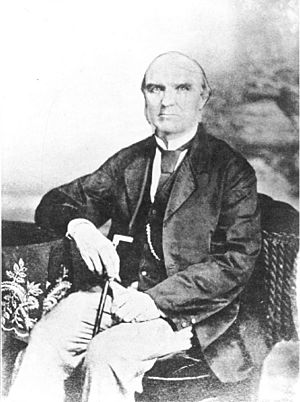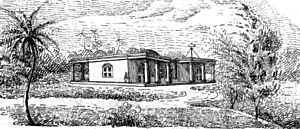N. R. Pogson facts for kids
Quick facts for kids
Norman Robert Pogson
|
|
|---|---|
 |
|
| Born | 23 March 1829 Nottingham, England
|
| Died | 23 June 1891 (aged 62) Chennai, India
|
| Nationality | English |
| Awards | Lalande Prize (1856) |
| Scientific career | |
| Fields | Astronomy |
Norman Robert Pogson (born March 23, 1829 – died June 23, 1891) was an English astronomer. He spent much of his career working in India at the Madras Observatory. He is famous for discovering several minor planets, which are like small planets. He also observed comets, which are icy space objects with tails.
One of his biggest contributions was creating a mathematical way to measure how bright stars appear from Earth. This system is still used today! He figured out that each step on his brightness scale (called stellar magnitudes) meant a star was about 2.512 times brighter or dimmer than the next. This number is known as Pogson's ratio.
Contents
Early Life and Learning
Norman Pogson was born in Nottingham, England. His father was a businessman. Even though his family wanted him to join the family business, Norman loved science. His mother encouraged him to follow his passion.
He mostly taught himself and left school at 16. By the time he was 18, he was already figuring out the paths of two comets! He learned a lot about astronomy at George Bishop's Observatory. In 1852, he became an assistant at the Radcliffe Observatory, where he worked with a special telescope called a Heliometer.
Working as an Astronomer
| 42 Isis | 23 May 1856 |
| 43 Ariadne | 15 April 1857 |
| 46 Hestia | 16 August 1857 |
| 67 Asia | 17 April 1861 |
| 80 Sappho | 2 May 1864 |
| 87 Sylvia | 16 May 1866 |
| 107 Camilla | 17 November 1868 |
| 245 Vera | 6 February 1885 |
After working at the South Villa Observatory, Pogson moved to the Radcliffe Observatory in Oxford in 1852. He won a special award called the Lalande medal for discovering a minor planet named Isis. While in Oxford, he studied stars that change in brightness and did other regular astronomy work.
In 1854, he even helped a famous scientist, Sir George Airy, with an experiment to figure out how dense the Earth is. Later, in 1859, Pogson became the director of the Hartwell Observatory. He wrote many papers about variable stars and minor planets during this time.
Moving to India
In October 1860, Norman Pogson was chosen to be the government astronomer for Madras (now Chennai) in India. He arrived in India in 1861 and started working at the Madras Observatory. He worked very hard there and discovered the asteroid 67 Asia. Over the next seven years, he found five more minor planets and seven variable stars.
Pogson also continued a big project started by another astronomer, T. G. Taylor. This project was a catalogue of over 11,000 stars. Pogson added more than 51,000 new observations to this catalogue. After he passed away, the catalogue was updated and published in 1901.
By the end of his life, Pogson had discovered many celestial objects. He found 134 stars, 106 variable stars (stars that change brightness), and even some possible supernovae (huge star explosions). He also went on special trips to observe things like a total solar eclipse in 1868. During this eclipse, he studied light from the sun and commented on a special line that was later linked to Helium, an element not yet discovered on Earth!
Pogson's Ratio
Pogson's most famous idea was about how we measure the brightness of stars. An ancient Greek astronomer named Hipparchus had a system where the brightest stars were "first magnitude" and the faintest visible stars were "sixth magnitude." Hipparchus noticed that first magnitude stars were about 100 times brighter than sixth magnitude stars.
In 1856, Pogson suggested making this a standard rule. He said that if a star is one magnitude brighter than another, it should be exactly the fifth root of 100 times brighter. This number is about 2.512. This means a first magnitude star is 2.512 times brighter than a second magnitude star, and so on. This important number is called Pogson's Ratio.
The mathematical way to show this relationship is:
- m1 - m2 = -2.5 log10 (L1 / L2)
Here, m stands for the star's brightness (magnitude) and L stands for its luminosity (how much light it gives off).
Comet Observations
Pogson also joined expeditions to observe solar eclipses in 1868 and 1871. In 1872, he received a strange telegram asking him to look for a comet near a star called Theta Centauri. The weather in Madras was cloudy, but when it cleared, he saw an object he thought was Biela's Comet. However, it turned out to be a different comet, which people sometimes call "Pogson's comet."
Norman Pogson worked at the Madras Observatory for 30 years without taking any time off. His health declined, and he passed away in June 1891. He is buried in Chennai, India.
Family Life
Norman Pogson was married twice and had many children. His first wife, Elizabeth Jane Ambrose, passed away in 1869. He later married Edith Louisa Stopford Sibley in 1883. One of the asteroids he discovered, 245 Vera, was named at the suggestion of his second wife, Edith.
His daughter, Elizabeth Isis Pogson, also became an astronomer. She worked as his assistant at the Madras Observatory from 1873 to 1881. She later became a meteorological reporter for Madras, studying weather. She was even one of the first women to be considered for a Fellowship of the Royal Astronomical Society in 1886, and she finally became a member in 1920.
Honors
Norman Pogson received several honors for his important work:
- He was made a Companion of the Most Eminent Order of the Indian Empire in 1878.
- An asteroid, 1830 Pogson, is named after him.
- A crater on the Moon, Pogson, is also named in his honor.
- The asteroid 42 Isis is believed to be named after his daughter, Elizabeth Isis Pogson.
See also
 In Spanish: Norman Pogson para niños
In Spanish: Norman Pogson para niños



